KiwiRail
KiwiRail Holdings Limited is a New Zealand state-owned enterprise responsible for rail operations in New Zealand, and operates inter-island ferries. Trading as KiwiRail and headquartered in Wellington, New Zealand, KiwiRail is the largest rail transport operator in New Zealand. KiwiRail has business units of KiwiRail Freight, The Great Journeys of New Zealand and Interislander. KiwiRail released a 10-Year Turn-around Plan in 2010 and has received significant government investment in support of this in an effort to make KiwiRail a viable long-term transport operator.
| State-Owned Enterprise | |
| Industry | Rail transport, shipping, property management |
| Predecessor | Toll NZ |
| Founded | 1 July 2008 |
| Headquarters | , |
Area served | New Zealand |
Key people | Brian Corban (Chairman)[1] Sue McCormack (Deputy Chair)[1] Greg Miller (CEO)[2] |
| Products | The Great Journeys of New Zealand |
| Services | Rail freight Inter-island ferries Long-distance passenger rail |
| Revenue | |
Number of employees | 3,700[3] |
| Divisions |
|
| Subsidiaries | KiwiRail Limited |
| Website | www |
History
Background
Prior to the establishment of KiwiRail, rail transport in New Zealand has been under both public and private ownership. Government operators included the Public Works Department (1873–1880), New Zealand Railways Department (1880–1982), and the New Zealand Railways Corporation (1982–1990). New Zealand Rail Limited was split off from the Railways Corporation (which continued to own the land beneath the rail network) in 1990, privatised in 1993 and then renamed in 1995 to Tranz Rail. In 2004 Tranz Rail's rail, ferry and trucking operations were acquired by Toll Holdings and renamed Toll NZ, with the central government buying back the rail network under the New Zealand Railways Corporation (trading as ONTRACK). As part of this acquisition, Toll agreed to pay ONTRACK Track Access Charges (TACs) in exchange for exclusive network access for 66 years, subject to a "use it or lose it clause": if freight and passenger volumes fell below their 2002-2004 average for three or more years, Toll would lose its exclusive access.[4] The agreement set a base track access fee but left future track access fees open to negotiation between ONTRACK and Toll.[4] After several years of negotiations, the two parties could not come to an agreement on the amount that Toll should pay.[5]
Establishment of KiwiRail


On 1 July 2008, the government announced the purchase for $690 million of Toll Rail, the rail and ferry assets of Toll NZ, but not its trucking operation.[6] The new company was named KiwiRail and launched on 1 October 2008 at a ceremony at Wellington railway station.[7] The New Zealand Railways Corporation then owned both KiwiRail and ONTRACK, with both companies merging to create one company that controls both rail and ferry operations and rail infrastructure.[8]
Jim Bolger became the first chair of the KiwiRail board, a position he held until 1 July 2010. A number of commentators,[7] including Winston Peters, view this as ironic. In response, Bolger acknowledged his involvement in privatising New Zealand Rail, remarking that "my life is full of ironies,"[9] and added that "the world has changed."[7]
Further restructuring: splitting of land and operations
In 2011, KiwiRail proposed splitting its land and rail corridor assets from its rail operation assets.[10] On 27 June 2012 it was announced by the company that the value of the land and rail operations would be written down from NZ$7.8 billion to $1.3 billion, and KiwiRail would continue as the rail and ferry operator, while the New Zealand Railways Corporation would manage KiwiRail's land.[11] The de-merger took effect on 31 December 2012.[12]
10-year Turnaround plan

In 2010 KiwiRail released a 10-year turnaround plan and significant government investment in support of this in the years following. In support of the turn-around plan, from July 2008 to December 2016 KiwiRail received over $2.1 billion of Crown investment, which was mostly spent on infrastructure and new rolling stock.[13]
Aims of the 10 Year Turnaround Plan
The focus of the Plan is to increase rail traffic volumes, revenue and productivity, modernise assets and separate out the commercial elements of the business from the non-commercial.[14]
The plan included the following points:[14]
- "Step change" on the Auckland – Wellington – Christchurch trunk route:
- Reduce transit time and improve reliability along the route by easing curves, removing speed restrictions, greater investment in renewal of bridges and sleepers and passing loops. An express freight train journey between Auckland and Wellington took thirteen and a half hours. KiwiRail aimed to reduce transit times to 11 hours.
- Improve exit and entry from Auckland and Wellington with improvements at terminals and on main lines to reduce transit times and conflicts with commuter services
- Increase ferry rail-freight capacity by extending the length of the Aratere (achieved 2011) and make the Kaitaki rail-capable (idea since abandoned)
- Improve reliability, capacity and enabling investment:
- Increased renewals on "other key routes", including investment in sleeper replacement, bridge strengthening and track formation refurbishment.
- Improved IT systems and processes, equipment and facilities at terminals
- New locomotives (see DL class) (48 in service by 2017) and 3,000 new wagons (over 1,000 in service by 2017).[15]
- Review of minor lines (close or mothball if no anchor customers emerge):
- North Auckland Line (partial mothball 2016)
- Stratford–Okahukura Line (mothballed 2009)
- Napier – Gisborne Line (partial mothballed 2012)[16]
- North Wairarapa line.
- Clarify and assign costs associated with Auckland and Wellington metro services (resulting in Tranz Metro assets being transferred to the Greater Wellington Regional Council and contracts for running services being made "contestable", as in Auckland.
Two of KiwiRail's major customers, Mainfreight and Fonterra, invested heavily in rail-related infrastructure in line with the Turnaround Plan. Mainfreight has allocated $60 million for investment in new railhead depots, while Fonterra has invested $130 million in a new rail hub complex in Hamilton and another in Mosgiel.[17]
Progress on the Turnaround Plan by June 2016
The plan has had mixed success, with company Chairman John Spencer stating in 2013 that for its first three years, rail freight revenue had increased by over 25%.[18] Similar progress in attaining new customers and increasing freight volumes has been made over the life of the Plan to date (other than with coal).
Steady and at times rapid progress has been made on the enabling parts of the Turnaround Plan, such as new locomotives and wagons, lengthening of the rail ferry and track destressing, but not always effectively.
The 10 Year Turnaround Plan was quickly undermined by a series of adverse events, including:
- Earthquakes: 2010 Canterbury earthquake, 2011 Christchurch earthquake, and the 2016 Kaikoura earthquake, resulting in significant infrastructure damage and closure of the Christchurch to Picton line from November 2016 to 15 September 2017[19]
- Lengthy severing of the rail ferry link between the North and South Islands when the Aratere lost a propeller in 2013[20][21]
- Significant and lengthy problems with the new DL class locomotives
- Pike River Mine disaster, leading to the mine's closure and the loss of revenue that had been anticipated from coal freight
- International coal price collapse
- Solid Energy, the largest NZ coal mining company, entering voluntary administration in 2015. This was the culmination of a downturn that had begun to appear in 2012–13: significantly less coal being moved from West Coast mines[12]
- Major rebuilding after fire damage and seven week closure of key freight route Midland line in 2017[22]
2017 update of the Turnaround Plan
Partially as a response to the events outlined above, in the 2017 budget the government announced a further $450 million in capital funding for KiwiRail, and that the company's operations would be placed under another major review, believed to relate to future funding models. The $450 million was earmarked for repairs following the 2016 Kaikoura earthquake and for further locomotive and rolling stock purchases. As part of the Turnaround Plan's agenda to standardise locomotives and wagons, in 2016 KiwiRail announced it would effectively switch off the NIMT electrification in late 2017 and replace the electric locomotives with an additional eight DL locomotives (additional to the 15 as reported in the 2016 Annual Report).[23] On 30 October 2018 that capital funding was made available to by the new Labour-led Coalition government to refurbish 15 of the surviving 20 EF locomotives at the Hutt Workshops extending the service life by 10 years for their continued use, in line with the Governments energy and emissions policies, and while the government is also actively considering extending the North Island electrification for the first time since the 1980s.[24]
KiwiRail has made use of the Government's Provincial Growth Fund (PGF). In 2019 KiwiRail signed an agreement with the New Zealand Transport Agency, Palmerston North City Council to construct a road, rail and air distribution centre in Palmerston North, following a $40 million allocation to KiwiRail from the PGF.[25]
New Zealand Rail Plan
In 2019, the government began a "Future of Rail" review, and in December 2019 released a draft New Zealand Rail Plan, outlining changes it proposed making to the rail transport industry and KiwiRail specifically.[26] The draft plan proposes a number of major changes, the most significant being future funding of the rail network through the National Land Transport Fund.[27] A number of other projects are proposed under the draft plan. They include a new train control centre in Auckland, replacing two Interislander ferries and rolling stock.[27]
KiwiRail business units
Freight
KiwiRail Freight is the company's largest business unit, making up the majority of KiwiRail's revenue with $390 million in the financial year ended July 2016. In the same year, KiwiRail moved around 18 million tonnes of freight and carried about 16% of New Zealand's total freight task (tonnes-km).[28]
Freight types: Bulk commodities include coal, logs, milk (dry and wet), IMEX (import/export intermodal) and domestic intermodal freight. Formerly large scale freight types such as petroleum products have entirely been withdrawn, and fertilizer has almost disappeared. The freight trading revenue by sector, as per the December 2016 Half Year Report is:[29]
- Domestic 27%
- Bulk 19%
- Forestry 15%
- Import/Export 39%
Rail freight depots: KiwiRail has a total of 16 rail freight depots. In the North Island, these are Whangarei, Auckland, Hamilton, Tauranga, New Plymouth, Napier, Whanganui, Palmerston North, and Masterton. In the South Island they are Blenheim, Christchurch, Ashburton, Timaru, Oamaru, Dunedin, and Invercargill.
Inland Ports: KiwiRail serves a number of Inland Port yards, although does not own the tracks. These include Conlinxx (Wiri), Midland Port (Rolleston), Longburn International Freight Hub (Longburn, Palmerston North), Manawatu Inland Port (Palmerston North), MetroPort (Southdown in Auckland and Rolleston in Christchurch) and will include Ruakura (Hamilton) when it opens in 2019,[30] and Ports of Auckland's site at Horotiu in Hamilton.[31]
Sea Ports: KiwiRail has major freight yards and sidings at Lyttelton port Company (containers, logs, coal), Port Chalmers (containers), Southport (Bluff), Timaru, Port of Tauranga (Mt Maunganui and Sulphur Point), Ports of Auckland, Centreport (Wellington), Port of Napier and New Plymouth. KiwiRail also has a joint venture with the Northland Regional Council to build a branch line (the Marsden Point Branch) to connect to Northport at Marsden Point.[32]
Anchor freight customers: Key anchor customers include Fonterra, Westland Dairy Products (Rolleston and Hokitika), Solid Energy and the various freight forwarders including Mainfreight and port companies including Port of Tauranga.
Freight wagons: KiwiRail operates 4,855 wagons. An additional 120 wagons were acquired in the year ending 2016, with over 1,000 new wagons added since 2008. One of KiwiRail's stated aims is to progressively move towards standardized wagons, with the container flat-top being overwhelmingly the dominant type (fitted with curtain sided swap bodies, liquid containers, log cradles and so on to meet almost all freight tasks). The Norwegian coupling is progressively being replaced with automatic Janney coupler on all wagons.
Key freight routes:
- Auckland - Christchurch: domestic general freight, mostly via 10', 20' and 40' containers and curtain-siders or box wagons.
- Auckland - Tauranga: Containerized and bulk export products
- Kinleith/Murapara - Mount Maunganui: wood products only
- Midland Line: Bulk export coal from north of Westport and Reefton, coal containers for Fonterra, dry and wet milk between Westland Dairy plants at Hokitika and Rolleston, export dry milk from Fonterra at Darfield.
- Edendale - Taieri - Port Chalmers: export milk powder in containers.
- Wairio - Invercargill: solely coal in containers for Fonterra use.
- Invercargill - Bluff: run as a 'shunt', sole freight is exports to Southport.
Interislander
Re-branded along with KiwiRail Scenic Journeys as the single brand The Great Journeys of New Zealand in 2017, The Interislander is the company's second largest business unit. It operates ferry services across Cook Strait between Wellington in the North Island and Picton in the South Island. In the financial year 2012, $123.9M of KiwiRail's revenue came from the Interislander, with the majority of the Interislander's revenue coming from rail and road freight transport.[33]
Current fleet
The Interislander operates three ferries. In 2011, the Aratere was extended by 30 m to add extra capacity.[34]
| Image | Name | Built | Entered service | Capacity | Notes | ||
|---|---|---|---|---|---|---|---|
| Passengers | Road | Rail | |||||
| DEV Aratere | 1998 | 1999 | 600 + 31 crew | 1050 lane metres [34] | 420 lane metres (32 wagons)[34] | Numbers are post 2011 modifications | |
 |
MS Kaiarahi | 1998 | 2014 | 550 | 1900 lane metres [35] | none | built 1998 as Dawn Merchant; chartered temporarily by Interislander in 2014 as Stena Alegra while Aratere was out of service, then chartered long-term in 2015 and renamed Kaiarahi |
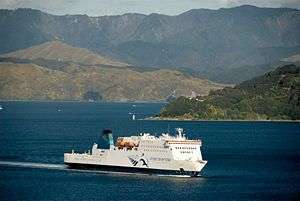 |
MV Kaitaki | 1994 | 2005 | 1350 + 60 crew | 1780 lane metres (550 cars) [36] | none | Built 1994 as Isle of Innisfree; chartered by Interislander in 2005 as Challenger; renamed Kaitaki 2007 |
Property and Corporate
KiwiRail is a major land owner in New Zealand, and manages over 18 thousand hectares of land, has in excess of 1,500 property assets with a combined value of over $965 million (Annual Report 2016). Increasingly, KiwiRail is pursuing a commercial approach to asset management, and in the 2016 financial year received over $18 million from property sales.[28]
Great Journeys of New Zealand
Re-branded along with Interislander as the single brand The Great Journeys of New Zealand in 2017, KiwiRail Scenic Journeys is the long-distance passenger transport subsidiary of KiwiRail, operating the Capital Connection, Northern Explorer, TranzAlpine and Coastal Pacific. The passenger trains are predominantly patronized by tourists to NZ, with the exception of the Capital Connection, which is a commuter train.
In 2012 KiwiRail attempted to sell Tranz Scenic,[37] but was unsuccessful, and KiwiRail continues to run these services. The division is now experiencing rapid double-digit annual growth, due to the growth of Chinese tourism to New Zealand, so much so that Kiwirail in 2017 may purchase an additional eight carriages [38] to the 17 AK carriages purchased in 2012.
Tranz Metro
Suburban rail passenger operations in Auckland and Wellington are contracted by their respective local governments and not operated by KiwiRail. In Auckland rolling stock is owned by Auckland Transport which has contracted operation to Transdev Auckland, while in Wellington rolling stock is owned by Greater Wellington Regional Council which has contracted operation to Transdev Wellington. Until 2016, KiwiRail division Tranz Metro had the contract to operate the Wellington services but lost a bid to renew this contract in 2015. KiwiRail, however, is sub-contracted by Transdev Wellington to provide and operate the diesel locomotives required to haul the Wairarapa Connection service.
Infrastructure and Asset Management
The KiwiRail Infrastructure and Engineering division, formerly known as ONTRACK, has three main areas of operation:
- Development, maintenance and operation of all of New Zealand's main-line rail infrastructure (see List of New Zealand railway lines).[40]
- Provides rail operators with access to the rail network in return for the payment of track access charges.
- Rail network controller, providing services such as train control and signalling.
The network it is responsible for consists of:
- Route length: 3,898 kilometres (2,422 mi)
- Tunnels: 149
- Bridges: 1,700
- Electrification: 95 km at 1.5 kV DC (Wellington area), 411 km at 25 kV 50 Hz AC (NIMT central section)
The divisions current (2016/2017) major project is refurbishment work in the Kaimai tunnel.
Engineering
The Engineering division provides mechanical assistance to the Freight and Passenger businesses, as well as to Auckland Transport. Engineering maintains, refurbishes and occasionally builds rolling stock for the network.
In 2012, KiwiRail announced it was putting its Hillside Engineering division on the market.[41] and subsequently sold part of the division and transferred remaining work to Hutt workshops.
KiwiRail now operates the Hutt Workshops in the Hutt Valley of Wellington, along with a number of small wagon maintenance depots, for example, at Addington (Christchurch) and Frankton.
Stabling yards
Most rail operations are a 'there and back' service with motive power being held in a few key strategic locations. Motive power stabling yards are as follows:
- Westfield (Auckland)
- Frankton (Hamilton)
- Palmerston North
- Thorndon (Wellington)
- Middleton (Christchurch)
- Dunedin
Yards and facilities
Some of the more prominent rail facilities used by KiwiRail include:
- Westfield, Auckland (adjacent to the closed Westfield station and near Westfield Junction)
- Southdown, Auckland
- Te Rapa, Fonterra bulk store yard, Hamilton
- Mount Maunganui
- Wellington
- Picton, Marlborough (solely used for marshaling wagons for rail ferry)
- Spring Creek (serves as rail head for Nelson)
- Middleton, Christchurch (largest yard in South Island)
- Dunedin
- Taieri, Fonterra bulk store facility, Mosgiel
Current rolling stock fleet
Locomotives
The table below lists only the current locomotives in service with KiwiRail.
| Image | Class | Introduced | Number in class | Number in service | Power output (kW) | Notes |
|---|---|---|---|---|---|---|
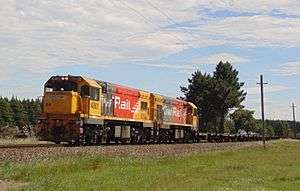 |
DC | 1978–1983 | 85 | 21 | 1230 | Mainline diesel-electric. Forty-four scrapped, fourteen stored, four preserved, and two sold overseas. Seventeen classed as DCP. |
 |
DF | 1979–1981 | 30 | 28 | 1800 | Mainline diesel-electric. Sub-classes: DFB (20) and DFT (10). One under overhaul to DFB. |
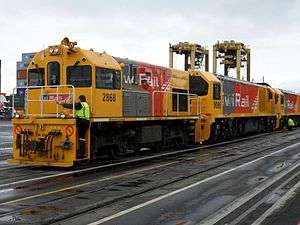 |
DH | 1978-1979 | 6 | 6 | 672 | Heavy shunting locomotive. |
 |
DL | 2010–2019 | 63 | 63 | 2700 | Mainline diesel-electric. |
 |
DSC | 1959–1967 | 70 | 27 | 315 | Light shunting. Thirty-four scrapped, two preserved, three stored and three owned by industrial owners. |
| DSG | 1981-1983 | 24 | 24 | 700 | Heavy shunting. One under overhaul. | |
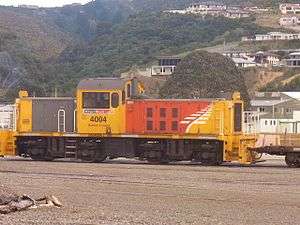 |
DSJ | 1984-1985 | 5 | 5 | 350 | Light shunting. |
 |
DX | 1972–1976 | 49 | 47 | 2240 | Mainline diesel-electric. One scrapped, one stored, and one under overhaul. Sub-classes: DXB, DXC, DXR (2). |
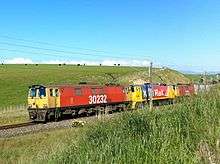 |
EF | 1988–1989 | 22 | 14 | 3000 | 25 kV AC electric locomotives. Six stored, two scrapped and two under overhaul. |
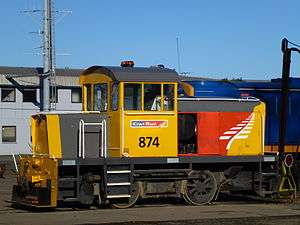 |
TR | 1936–1978 | 90 | 17 | 138 | Light shunting, positioned in smaller yards and leased to industrial customers. Forty-four scrapped, twenty-eight preserved and one stored. |
Carriages
| Image | Class | Number in class | In service | Passenger capacity | Notes |
|---|---|---|---|---|---|
| AK carriage | 17 | 2012–present | AK 63; AKC 10 | Used on the Tranz Alpine, Coastal Pacific, Northern Explorer services | |
| S class carriages | 8 | 1999–present | 60 | Used on Capital Connection service. |
Corporate governance
| Executive Board[1][42] | |
| Brian Corban | Chairman (Trevor Janes resigned 30 June 2018, was acting until Greg Miller took up the post, then was Deputy until Miller became the new CEO)[43] |
| Sue McCormack | Deputy Chair (was Dame Paula Rebstock until 2018 then Brian Corban until he was made Chair) |
| Noel Coom | Director |
| Hazel Armstrong | Director |
| Fiona Mules | Director |
| Rachel Pinn | Director |
| Mike Williams | Director |
| Executive Team[2] | |
| Greg Miller | Chief Executive |
| Rod Lay | Chief Financial Officer |
| Todd Moyle | Chief Operations Offier/Deputy Chief Executive Officer |
| Garry Collings | Group Chief Information Officer |
| Ellie Martel | Group General Manager Communications |
| Stephanie Campbell | Group General Manager Property |
| Usman Pervaiz | Group General Manager Innovation and Strategic Growth |
| David Gordon | Chief Operating Officer – Capital Projects and Asset Development |
| Andrew Norton | Group General Manager Human Resources |
| Katie McMahon | Group General Manager Zero Harm |
| Jonathon Earl | Group General Counsel |
See also
Notes
References
- "Board of Directors". KiwiRail. Retrieved 4 December 2019.
- "KiwiRail - Executive Team". KiwiRail. Retrieved 4 May 2019.
- "KiwiRail Integrated Report 2019". Retrieved 10 October 2019.
- "National Rail Access Agreement" (PDF). New Zealand Treasury. 2004. Retrieved 18 February 2019.
- "Toll says slowdown is affecting it". 31 January 2007. Retrieved 22 May 2019.
- "KiwiRail - Brief rail history". KiwiRail. Retrieved 8 May 2019.
- "Government purchase of rail business closed one rail history chapter and opened another". KiwiRail. Retrieved 8 May 2019.
- "Annual Report 2008-09" (PDF). KiwiRail. Retrieved 23 April 2015.
- Young, Audrey (2 July 2008). "Govt: We paid top dollar for rail". The New Zealand Herald. Retrieved 22 May 2019.
- "No ulterior motive to sell off land or business says KiwiRail". Radio New Zealand. 31 October 2011.
- Adam Bennett (27 June 2012). "Huge writedown in KiwiRail value".
- "Positive growth continues alongside improvements to business capability". KiwiRail. 28 February 2013.
- "KiwiRail funding since July 2008'". 10 March 2017.
- "Overview of KiwiRail's turnaround plan" (PDF). KiwiRail. 5 May 2010. Retrieved 6 August 2010.
- "KiwiRail Orders Another 20 Chinese Locomotives". Otago Daily Times. 20 July 2011. Retrieved 22 July 2011.
- "KiwiRail to mothball Napier-Gisborne Line". KiwiRail. 2 October 2012. Archived from the original on 6 February 2013. Retrieved 15 October 2012.
- "KiwiRail survival plan is on track". The Dominion Post. 25 September 2010. Retrieved 25 September 2010.
- "KiwiRail growth momentum 'still on track'". 25 October 2013.
- "Engineer trapped in Kaikoura quake drives first train into Christchurch as line reopens". NZ Herald. 15 September 2017. Retrieved 16 September 2017.
- "Ferry out of action after losing propeller". Stuff.co.nz. 24 November 2013. Retrieved 16 September 2017.
- "KiwiRail ignored advice when fitting failed Interislander ferry propeller - report". Stuff.co.nz. 15 December 2016. Retrieved 16 September 2017.
- "Midland line closed by fire".
- "KiwiRail to dump electrics". Stuff.co.nz. 21 December 2016.
- "Government Saves Electric Trains". Scoop Parliament. 30 October 2018. Retrieved 22 May 2019.
- Janine Rankin (6 June 2019). "KiwiRail freight plans complement city and transport investment". Manawatu Standard.
- {{cite web|url=https://www.transport.govt.nz/rail/the-draft-new-zealand-rail-plan/%7Cpublisher=[[Ministry of Transport (New Zealand)|date=12 December 2019|accessdate=16 December 2019|title=The Draft New Zealand Rail Plan}}
- "KiwiRail investment through Land Transport fund: government proposal 'historic' - chief exec". Radio New Zealand. 14 December 2019. Retrieved 16 December 2019.
- "KiwiRail Annual Report 2015-2016" (PDF). KiwiRail. Retrieved 8 March 2019.
- "KiwiRail Half Year Report 2016" (PDF). KiwiRail.
- Andrea Fox (9 February 2019). "Ruakura inland port jigsaw puzzle coming together, slowly". New Zealand Herald.
- Libby Wilson (30 April 2019). "Multimillion dollar inland port to bring jobs and products to the Waikato". Stuff.co.nz. Retrieved 2 May 2019.
- "KiwiRail Annual Report 2012-2013" (PDF). KiwiRail. Retrieved 8 March 2019.
- "KiwiRail Annual Report 2011-2012" (PDF). Archived from the original (PDF) on 1 June 2013. Retrieved 5 November 2014.
- "Facts and Figures - Aratere". The Interislander.
- "Facts and Figures - Kaiarahi". The Interislander.
- "Facts and Figures - Kaitaki". The Interislander.
- "Opposition parties criticise TranzScenic plans". Radio New Zealand. 1 August 2012.
- "KiwiRail may spend $50M on new carriages". 7 May 2017.
- "Half-million dollar rail project at Waitati". Otago Daily Times. 22 September 2009. Retrieved 26 September 2009.
- "Companies Office – ONTRACK Infrastructure Limited". Retrieved 25 September 2010.
- "KiwiRail Putting Hillside Workshops Up for sale". Radio New Zealand. 19 April 2012.
- "Board of Directors". www.kiwirail.co.nz. Retrieved 19 October 2018.
- "Brian Corban appointed KiwiRail Chair". The Beehive. Retrieved 4 December 2019.
External links
KiwiRail subsidiaries
Articles about KiwiRail
- KiwiRail value halves, 'BusinessDay, 3 June 2009.
- KiwiRail under price pressure, 'BusinessDay, 17 April 2009.
- MP at a loss after KiwiRail rejects plea, 'The Marlborough Express, 16 April 2009.
- Trains now called KiwiRail, 'Dominion Post, 30 June 2008.